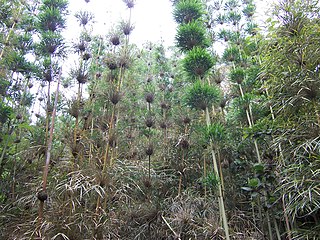
The Madagascar lowland forests or Madagascar humid forests are a tropical moist broadleaf forest ecoregion found on the eastern coast of the island of Madagascar, home to a plant and animal mix that is 80 to 90% endemic, with the forests of the eastern plain being a particularly important location of this endemism. They are included in the Global 200 list of outstanding ecoregions.

The bamboo lemurs or gentle lemurs are the lemurs in genus Hapalemur. These medium-sized primates live exclusively on Madagascar.
Hickelia is a genus of African bamboo in the grass family.
- Hickelia africanaS.Dransf. - Tanzania
- Hickelia alaotrensisA.Camus - Madagascar
- Hickelia madagascariensisA.Camus - Madagascar
- Hickelia perrieri(A.Camus) S.Dransf. - Madagascar

Nastus is a genus of slender, erect, scrambling or climbing bamboos in the grass family. It is native to Southeast Asia, Papuasia, and certain islands in the Indian Ocean.

The golden bamboo lemur, bokombolomena or varibolomena in Malagasy, is a medium-sized bamboo lemur endemic to south-eastern Madagascar.

The greater bamboo lemur, also known as the broad-nosed bamboo lemur and the broad-nosed gentle lemur, is a species of lemur endemic to the island of Madagascar.

Bambusa vulgaris, common bamboo, is an open-clump type bamboo species. It is native to Indochina and to the province of Yunnan in southern China, but it has been widely cultivated in many other places and has become naturalized in several regions. Among bamboo species, it is one of the largest and most easily recognized.
Dypsis ligulata is a species of flowering plant in the family Arecaceae. It is found only in Madagascar. It is threatened by habitat loss.

Dypsis madagascariensis is a species of flowering plant in the family Arecaceae. It is found only in Madagascar. It is threatened by habitat loss.
Dypsis onilahensis is a species of palm tree in the family Arecaceae. It is endemic to Madagascar as is reflected in the species name (onilahensis) referring to the Onilahy River, south of Toliara. It is threatened by habitat loss.

Satranala decussilvae is a species of flowering plant in the Arecaceae family. It is a palm endemic to Madagascar. It is the only species in the genus Satranala, and is threatened by habitat loss. There are perhaps 200 mature individuals remaining.

Chasechloa is a grass genus in the tribe Paniceae, endemic to Madagascar. It was described by French botanist Aimée Antoinette Camus in 1948, who named it in honour of Mary Agnes Chase. Its two species were also classified in the genera Echinolaena and Panicum, but phylogenetic analysis confirmed that they form a distinct lineage.
Lecomtella is a genus of grasses with the sole species Lecomtella madagascariensis, native to Madagascar. It is the only genus in the tribe Lecomtelleae.

Beccariophoenix alfredii, also known as the high plateau coconut palm, is a recently discovered species of Arecaceae (palms), endemic to Madagascar. It is in the genus Beccariophoenix, and is closely related to the genus Cocos. Beccariophoenix alfredii is very similar in appearance to the coconut palm, although somewhat cold hardy, making it a good look-alike for the coconut in cooler climates.
Dypsis brevicaulis is a species of flowering plant in the Arecaceae family. It is a dwarf palm found on only three sites in Madagascar, with fewer than fifty plants ever found in the wild. The plant is part of the IUCN Sampled Red List Index for Plants, a study of representative species from all over the world which is studying extinction trends for plants.
Cathariostachys is a genus of Madagascan bamboo in the grass family.
- Cathariostachys capitata - eastern Madagascar
- Cathariostachys madagascariensis(A.Camus) S.Dransf. - central Madagascar

Valiha is a bamboo genus in the tribe Bambuseae found in Madagascar. The genus is named after a musical instrument, the valiha, which was formerly constructed from the culms of this plant.
John Dransfield is an honorary research fellow and former head of palm research at the Royal Botanic Gardens, Kew, United Kingdom, as well as being an authority on the phylogenetic classification of palms.
Dendrocalamus giganteus, commonly known as giant bamboo, is a giant tropical and subtropical, dense-clumping species native to Southeast Asia. It is one of the largest bamboo species in the world.
Soejatmi Dransfield is an Indonesia-born British plant taxonomist specializing in bamboos and currently honorary research fellow at the Royal Botanic Gardens, Kew, UK.










